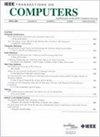The Graph Structure of Baker's Maps Implemented on a Computer
IF 3.6
2区 计算机科学
Q2 COMPUTER SCIENCE, HARDWARE & ARCHITECTURE
引用次数: 0
Abstract
The complex dynamics of the baker's map and its variants in infinite-precision mathematical domains and quantum settings have been extensively studied over the past five decades. However, their behavior in finite-precision digital computing remains largely unknown. This paper addresses this gap by investigating the graph structure of the generalized two-dimensional baker's map and its higher-dimensional extension, referred to as HDBM, as implemented on the discrete setting in a digital computer. We provide a rigorous analysis of how the map parameters shape the in-degree bounds and distribution within the functional graph, revealing fractal-like structures intensify as parameters approach each other and arithmetic precision increases. Furthermore, we demonstrate that recursive tree structures can characterize the functional graph structure of HDBM in a fixed-point arithmetic domain. Similar to the 2-D case, the degree of any non-leaf node in the functional graph, when implemented in the floating-point arithmetic domain, is determined solely by its last component. We also reveal the relationship between the functional graphs of HDBM across the two arithmetic domains. These findings lay the groundwork for dynamic analysis, effective control, and broader application of the baker's map and its variants in diverse domains.在计算机上实现的贝克地图的图形结构
在过去的五十年里,在无限精确的数学领域和量子环境中,贝克图及其变体的复杂动力学已经得到了广泛的研究。然而,它们在有限精度数字计算中的行为在很大程度上仍然未知。本文通过研究广义二维贝克图及其高维扩展(称为HDBM)的图结构,在数字计算机的离散设置上实现,解决了这一差距。我们对映射参数如何在函数图中形成度内边界和分布进行了严格的分析,揭示了分形结构随着参数相互接近和算术精度的增加而增强。此外,我们还证明了递归树结构可以在不动点算术域中描述HDBM的功能图结构。与二维情况类似,当在浮点算术域中实现时,函数图中任何非叶节点的度数仅由其最后一个分量决定。我们还揭示了HDBM在两个算术域上的函数图之间的关系。这些发现为动态分析、有效控制和面包师地图及其变体在不同领域的更广泛应用奠定了基础。
本文章由计算机程序翻译,如有差异,请以英文原文为准。
求助全文
约1分钟内获得全文
求助全文
来源期刊

IEEE Transactions on Computers
工程技术-工程:电子与电气
CiteScore
6.60
自引率
5.40%
发文量
199
审稿时长
6.0 months
期刊介绍:
The IEEE Transactions on Computers is a monthly publication with a wide distribution to researchers, developers, technical managers, and educators in the computer field. It publishes papers on research in areas of current interest to the readers. These areas include, but are not limited to, the following: a) computer organizations and architectures; b) operating systems, software systems, and communication protocols; c) real-time systems and embedded systems; d) digital devices, computer components, and interconnection networks; e) specification, design, prototyping, and testing methods and tools; f) performance, fault tolerance, reliability, security, and testability; g) case studies and experimental and theoretical evaluations; and h) new and important applications and trends.
 求助内容:
求助内容: 应助结果提醒方式:
应助结果提醒方式:


